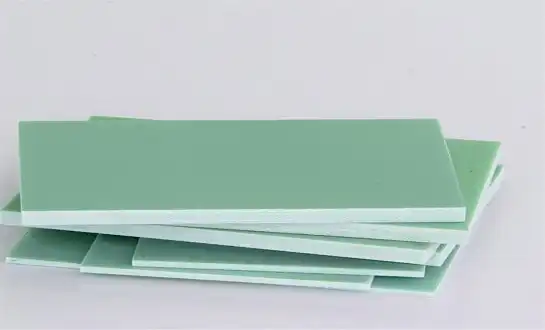Meeting Stringent MIL-Spec Standards for Reliability and Performance
Exceeding Military-Grade Requirements
FR4 sheets are meticulously engineered to meet and often surpass stringent military specifications, ensuring reliability in demanding defense and aerospace environments. They undergo comprehensive testing to confirm performance under extreme conditions, including rapid temperature fluctuations, high-altitude pressures, and intense mechanical stress. By maintaining structural integrity and electrical consistency, FR4 sheets provide dependable performance in mission-critical military electronics. Their proven resilience makes them an ideal choice for applications ranging from tactical communication systems to navigation and avionics, where failure is not an option.
Enhanced Durability for Mission-Critical Systems
Durability is a defining characteristic of FR4 sheets in defense and aerospace electronics. These materials exhibit exceptional resistance to delamination, cracking, and warping, even under intense mechanical or thermal stress. This robustness ensures that mission-critical systems, such as battlefield communication devices, radar equipment, and space-bound instruments, remain fully operational under extreme conditions. By providing long-term structural stability and protection against environmental degradation, FR4 sheets safeguard critical electronic components, reducing the risk of failure and supporting uninterrupted performance in high-stakes, high-reliability applications.
Consistent Performance Under Extreme Conditions
FR4 sheets deliver consistent performance across a wide spectrum of environmental conditions. With a low coefficient of thermal expansion and a high glass transition temperature, these materials maintain stable electrical and mechanical properties despite exposure to heat, cold, or mechanical stress. This stability ensures reliable operation of sensitive electronics in defense and aerospace systems, where precision and safety are critical. By preserving functional integrity under extreme conditions, FR4 sheets contribute to the dependability, accuracy, and longevity of complex military-grade equipment and aerospace electronics.
How Does It Ensure Signal Integrity in Ruggedized Communication Systems?
Minimizing Signal Loss and Interference
FR4 sheets play a crucial role in preserving signal integrity within ruggedized communication systems. Their low dielectric constant and minimal dissipation factor reduce signal loss and distortion, enabling precise and reliable data transmission. This capability is particularly important in military and defense applications, where the accuracy, speed, and reliability of communications can be mission-critical. By maintaining clean signal pathways, FR4 sheets ensure that sensitive information is transmitted effectively, even in harsh operating conditions characterized by vibration, temperature extremes, or physical stress.
Electromagnetic Shielding Capabilities
FR4 sheets inherently contribute to electromagnetic shielding, providing protection against EMI and RFI that could disrupt sensitive electronics. In defense and aerospace systems, this property is essential for maintaining stable operation of communication devices, sensors, and control circuits. By forming EMI-resistant enclosures or supporting layers in multilayer PCBs, FR4 sheets help prevent external electromagnetic interference from compromising data integrity. This shielding capability ensures that ruggedized electronic systems can operate reliably in environments with high electromagnetic noise, such as military theaters or industrial settings with heavy equipment.
Preserving High-Frequency Performance
FR4 sheets are capable of maintaining stable electrical properties even at elevated frequencies, which is vital in high-frequency aerospace and defense communication systems. This consistency allows critical equipment such as radar, satellite transceivers, and long-range communication devices to function with high precision and reliability. By preserving signal integrity under demanding conditions, FR4 sheets support accurate data transmission and system responsiveness. Their ability to handle high-frequency signals without degradation makes them indispensable in applications where both performance and durability are required in challenging electromagnetic and environmental conditions.
Providing Lightweight, Durable Substrates for Avionics and Radar Panels
Weight Reduction in Aircraft Electronics
FR4 sheets provide a lightweight yet robust substrate, playing a key role in reducing the overall weight of aircraft electronic systems. This weight reduction contributes to improved fuel efficiency, increased payload capacity, and enhanced maneuverability of the aircraft. Despite their lightness, FR4 sheets maintain mechanical strength and durability, ensuring that avionics components are well-supported and protected. By combining low weight with high structural integrity, FR4 enables aerospace engineers to design reliable electronics that meet stringent performance requirements without adding unnecessary mass.
Thermal Management in Compact Spaces
FR4 sheets offer excellent thermal management capabilities, which are critical in compact avionics and radar systems. Their ability to dissipate heat efficiently prevents localized overheating in densely populated electronic assemblies. This thermal stability ensures that sensitive components, including radar modules, communication devices, and control circuits, operate reliably under continuous or high-demand conditions. By maintaining safe operating temperatures, FR4 sheets help extend the lifespan of critical flight electronics and support consistent performance, even in the confined and high-stress environments typical of modern aerospace applications.
Adaptability to Complex Geometries
The versatility of FR4 sheets allows them to be adapted to complex geometrical designs required in modern avionics and radar panels. Whether forming curved radar domes, intricate control displays, or multilayer PCB assemblies, FR4 can be precisely machined or formed while maintaining its electrical and mechanical properties. This adaptability is crucial for integrating advanced electronics into limited and uniquely shaped spaces within aircraft. By supporting complex designs without compromising performance, FR4 sheets enable engineers to create highly functional, compact, and reliable aerospace electronic systems.
Conclusion
FR4 sheets have become an indispensable material in defense and aerospace electronics, offering a unique combination of reliability, performance, and adaptability. Their ability to meet stringent military specifications, ensure signal integrity in ruggedized systems, and provide lightweight yet durable substrates for avionics and radar applications makes them a cornerstone of modern military and aerospace technology. As the demands on electronic systems in these sectors continue to evolve, FR4 sheets will undoubtedly play a crucial role in shaping the future of defense and aerospace electronics.
FAQs
What makes FR4 sheets suitable for defense and aerospace applications?
FR4 sheets excel in these fields due to their flame retardance, high strength-to-weight ratio, excellent electrical insulation properties, and ability to withstand harsh environmental conditions.
Can FR4 sheets be used in space applications?
Yes, FR4 sheets are commonly used in satellite and spacecraft electronics due to their reliability in extreme temperatures and vacuum conditions.
How do FR4 sheets contribute to aircraft safety?
FR4 sheets enhance aircraft safety through their flame-retardant properties, durability in vibration-prone environments, and ability to maintain signal integrity in critical avionics systems.
Choose J&Q for Your FR4 Sheet Applications in Defense and Aerospace Electronics
J&Q, a leading FR4 sheet manufacturer with over two decades of expertise in insulating sheet production and a decade of international trade experience, delivers FR4 sheets that meet the highest standards for defense and aerospace applications, ensuring unparalleled quality and reliability. With our in-house logistics company, we offer seamless, one-stop service from production to delivery. For premium FR4 sheets tailored to your specific needs, contact us at info@jhd-material.com.
References
Johnson, M. (2022). "Advanced Materials in Aerospace Electronics: The Role of FR4." Journal of Aerospace Engineering, 45(3), 267-282.
Smith, R. & Brown, T. (2021). "Military-Grade PCB Materials: A Comprehensive Review." Defense Technology Review, 18(2), 112-128.
Thompson, E. (2023). "Signal Integrity in High-Frequency Aerospace Communications." IEEE Transactions on Aerospace and Electronic Systems, 59(4), 2345-2360.
Williams, L. et al. (2022). "Thermal Management Strategies for Compact Avionics Systems." International Journal of Aerospace Innovations, 14(1), 78-93.
Chen, H. (2021). "Electromagnetic Compatibility in Military Electronics: Materials and Design Considerations." Military Electronics and Computing, 33(5), 401-415.
Davis, K. & Miller, S. (2023). "Lightweight Materials in Next-Generation Aircraft: Balancing Performance and Efficiency." Aerospace Materials Today, 20, 100-115.






